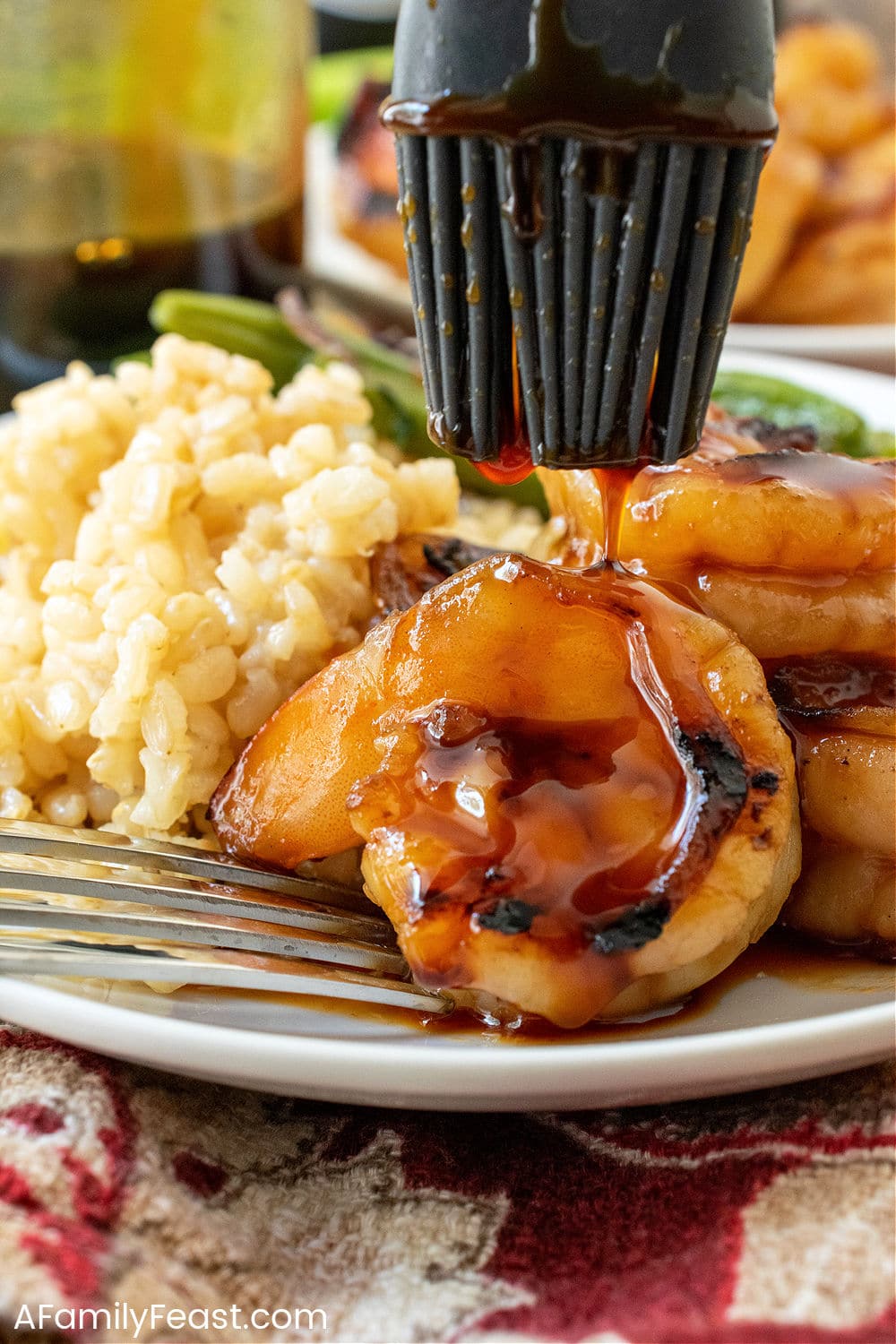Craving a taste of Japan? Try making your own Japanese barbecue sauce.
This sauce adds a burst of flavor to any dish. Japanese barbecue sauce, known as “tare,” is a delicious blend of sweet, savory, and umami flavors. It’s perfect for marinating meats, dipping, or even brushing on grilled vegetables. The sauce is versatile and can elevate your meals to a new level.
You can easily prepare this sauce at home with simple ingredients. This saves you from buying store-bought versions filled with preservatives. Plus, making it yourself ensures that you can adjust the flavors to your liking. Ready to get started? Let’s dive into the world of Japanese barbecue sauce and discover how you can bring these unique flavors to your kitchen.

Credit: bachans.com
Essential Ingredients
Creating an authentic Japanese barbecue sauce requires a few key ingredients. These ingredients bring out the unique flavors that make this sauce special. Let’s explore the essentials.
Key Components
To make an authentic Japanese barbecue sauce, you need certain key components. Here is a list of the most essential ingredients:
- Soy Sauce: Adds a savory taste and deep umami flavor.
- Mirin: A sweet rice wine that balances the salty soy sauce.
- Sake: Adds depth and complexity to the sauce.
- Sugar: Provides sweetness and helps caramelize the meat.
- Garlic: Gives a robust and aromatic flavor.
- Ginger: Adds a warm, spicy note.
- Sesame Oil: Enhances the richness of the sauce.
These ingredients are the foundation of a good Japanese barbecue sauce. Each one plays a vital role in creating the perfect balance of flavors.
Where To Find Ingredients
Finding these ingredients is easier than you might think. Here are some tips on where to find them:
- Asian Markets: These stores often carry all the essential ingredients.
- Online Retailers: Websites like Amazon offer a wide selection of Asian ingredients.
- Local Grocery Stores: Many stores have an international aisle with these items.
- Specialty Stores: Look for stores that specialize in Japanese or Asian cuisine.
By knowing where to find these ingredients, you can easily gather everything you need. This makes the process of making Japanese barbecue sauce simple and straightforward.

Credit: www.afamilyfeast.com
Preparation Steps
Creating your own Japanese Barbecue Sauce at home is a rewarding task. This section will guide you through the essential preparation steps. From gathering the right ingredients to mixing and cooking, follow these steps for a delicious sauce.
Gathering Ingredients
Start by collecting all the necessary ingredients. The key elements of a Japanese Barbecue Sauce include:
- Soy sauce – 1/2 cup
- Mirin (sweet rice wine) – 1/4 cup
- Sake – 1/4 cup
- Sugar – 1/4 cup
- Garlic, minced – 2 cloves
- Ginger, grated – 1 tablespoon
- Soybean paste (miso) – 1 tablespoon
- Sriracha (optional for spice) – 1 teaspoon
These ingredients create the perfect balance of sweet, salty, and umami flavors.
Mixing And Cooking
Once you have gathered all the ingredients, follow these steps:
- Combine the soy sauce, mirin, sake, and sugar in a medium saucepan.
- Heat the mixture over medium heat, stirring constantly until the sugar dissolves.
- Add the minced garlic and grated ginger to the saucepan.
- Stir in the soybean paste (miso) until it is fully incorporated.
- If you want a bit of heat, add the Sriracha at this point.
- Bring the mixture to a boil, then reduce the heat and let it simmer for 10 minutes. Stir occasionally.
- Remove the sauce from heat and let it cool. The sauce will thicken as it cools.
Store the sauce in an airtight container in the refrigerator. It will keep for up to two weeks.
Enjoy your homemade Japanese Barbecue Sauce with grilled meats, vegetables, or as a marinade!
Flavor Variations
Japanese barbecue sauce, known as Yakiniku no Tare, offers diverse flavor profiles. The base combines soy sauce, mirin, and sugar. But variations can make it unique. Here, explore two popular flavor variations: Sweet and Tangy and Spicy and Bold.
Sweet And Tangy
The Sweet and Tangy variation balances sweetness with a hint of acidity. This flavor profile appeals to those who enjoy a milder, well-rounded taste. Below is a simple recipe to achieve this delicious combination:
- Ingredients:
- 1/2 cup soy sauce
- 1/4 cup mirin
- 3 tablespoons honey
- 2 tablespoons rice vinegar
- 2 cloves garlic, minced
- 1 tablespoon grated ginger
- In a bowl, mix all the ingredients.
- Whisk until the honey dissolves.
- Let the sauce sit for 30 minutes before using.
This Sweet and Tangy sauce pairs well with grilled chicken and vegetables. It adds a delightful flavor to your barbecue dishes.
Spicy And Bold
The Spicy and Bold variation caters to those who love a kick in their sauce. This version brings heat, making your barbecue exciting and flavorful. Follow this easy recipe to create this fiery delight:
- Ingredients:
- 1/2 cup soy sauce
- 1/4 cup mirin
- 2 tablespoons gochujang (Korean chili paste)
- 1 tablespoon sesame oil
- 2 cloves garlic, minced
- 1 tablespoon grated ginger
- 1 tablespoon sugar
- Combine all the ingredients in a bowl.
- Whisk until well mixed.
- Let the sauce rest for 30 minutes.
This Spicy and Bold sauce is perfect for beef and pork dishes. It enhances the meat’s flavor with its robust and spicy profile.
Serving Suggestions
The rich and savory flavors of Japanese barbecue sauce are truly versatile. This sauce enhances any dish, whether meat-based or vegetarian. Here are some delicious serving suggestions to inspire your next meal.
Pairing With Meats
The bold and umami-rich Japanese barbecue sauce complements various meats beautifully. Here are some ideas:
- Grilled Chicken: Brush the sauce on chicken thighs or breasts. Grill until caramelized and juicy.
- Pork Ribs: Slather the sauce on pork ribs. Slow-cook until tender and flavorful.
- Beef Skewers: Marinate beef chunks in the sauce. Skewer with vegetables and grill for a tasty treat.
- Steak: Serve the sauce as a dipping option with a perfectly cooked steak.
Vegetarian Options
Japanese barbecue sauce is not just for meat lovers. It enhances vegetarian dishes too. Here are some vegetarian options:
- Grilled Tofu: Marinate tofu in the sauce. Grill until crispy and serve hot.
- Vegetable Skewers: Coat mixed vegetables like bell peppers, zucchini, and mushrooms with the sauce. Grill or roast for a flavorful side.
- Stir-fried Veggies: Add the sauce to stir-fried vegetables. Serve over rice or noodles for a quick meal.
- Roasted Eggplant: Brush eggplant slices with the sauce. Roast until tender and caramelized.
| Meat Options | Vegetarian Options |
|---|---|
| Grilled Chicken | Grilled Tofu |
| Pork Ribs | Vegetable Skewers |
| Beef Skewers | Stir-fried Veggies |
| Steak | Roasted Eggplant |
Storage Tips
Storing your Japanese barbecue sauce correctly ensures it stays fresh and tasty. Proper storage helps maintain its unique flavor and texture. Follow these simple tips to keep your sauce in perfect condition.
Refrigeration
Place your Japanese barbecue sauce in an airtight container. This prevents exposure to air and bacteria. Store it in the refrigerator to keep it fresh for up to 2 weeks. Use a clean spoon every time you take some out. This avoids contamination and extends its shelf life. Always label your container with the date you made the sauce.
Freezing
If you want to keep your sauce longer, freezing is a great option. Pour the sauce into a freezer-safe container or ice cube tray. This makes it easy to use small portions later. Cover the container tightly to prevent freezer burn.
- Freeze sauce in small portions.
- Label with the date of freezing.
- Thaw in the refrigerator overnight before use.
Frozen Japanese barbecue sauce can last up to 3 months without losing flavor. Remember to reheat gently on the stove to preserve its taste.
| Storage Method | Duration |
|---|---|
| Refrigeration | Up to 2 weeks |
| Freezing | Up to 3 months |
Proper storage ensures that your Japanese barbecue sauce remains delicious and safe to eat. Enjoy your homemade sauce with every meal!
Common Mistakes
Creating the perfect Japanese barbecue sauce can be tricky. While the ingredients are simple, the execution is where many people falter. Let’s explore some common mistakes to avoid for a delicious and authentic sauce.
Overcooking
Overcooking is a common mistake in making Japanese barbecue sauce. When you cook the sauce for too long, it can become too thick or even burn. This changes its flavor and texture.
The sauce should be cooked on medium heat. As soon as it starts to thicken, remove it from the heat. Keep stirring to prevent it from sticking to the pan.
Incorrect Measurements
Measurement errors can ruin the balance of flavors in your sauce. Japanese barbecue sauce relies on a perfect balance of sweet, salty, and umami flavors.
Here is a basic measurement guide:
| Ingredient | Measurement |
|---|---|
| Soy Sauce | 1/2 cup |
| Sake | 1/4 cup |
| Mirin | 1/4 cup |
| Sugar | 2 tablespoons |
Always use the correct measurements for each ingredient. A little too much or too little can affect the overall taste. Use measuring spoons and cups for accuracy.
Health Benefits
Japanese barbecue sauce is not only delicious but also offers several health benefits. It can enhance your meal while providing essential nutrients. Discover how this sauce can be a healthy addition to your diet.
Nutritional Information
The nutritional profile of Japanese barbecue sauce is quite impressive. Here is a table showing the key nutrients per serving:
| Nutrient | Amount per Serving |
|---|---|
| Calories | 50 |
| Protein | 1g |
| Carbohydrates | 12g |
| Sugars | 10g |
| Sodium | 300mg |
| Fat | 0g |
Low in calories and fat-free, this sauce provides a healthy flavor boost.
Low-calorie Alternatives
Making a low-calorie version of Japanese barbecue sauce is simple. Here are some tips:
- Use natural sweeteners like honey or agave nectar instead of sugar.
- Reduce sodium by using low-sodium soy sauce.
- Add fresh ginger and garlic for extra flavor without added calories.
These alternatives can help maintain flavor while reducing calorie intake.

Credit: masonfit.com
Frequently Asked Questions
What Ingredients Are In Japanese Barbecue Sauce?
Japanese barbecue sauce typically includes soy sauce, mirin, sugar, garlic, ginger, and sake. Some variations may also contain sesame oil, rice vinegar, or miso paste. These ingredients create a rich, savory, and slightly sweet flavor profile.
How Do You Use Japanese Barbecue Sauce?
Japanese barbecue sauce can be used as a marinade, a basting sauce, or a dipping sauce. It’s perfect for grilled meats, vegetables, and even tofu. Simply brush it on during cooking or serve it on the side.
Can I Store Homemade Japanese Barbecue Sauce?
Yes, you can store homemade Japanese barbecue sauce in an airtight container. Keep it in the refrigerator for up to two weeks. Make sure to stir well before each use to ensure the ingredients are well mixed.
Is Japanese Barbecue Sauce Gluten-free?
Traditional Japanese barbecue sauce may contain soy sauce, which typically has gluten. To make it gluten-free, use tamari or a gluten-free soy sauce alternative. Always check labels to ensure all ingredients are gluten-free.
Conclusion
Enjoy creating this delicious Japanese barbecue sauce at home. It’s simple and tasty. Perfect for grilling or as a dip. Your family will love it. Experiment with flavors to suit your taste. Share this recipe with friends. They will appreciate the unique twist.
Cooking at home brings joy and satisfaction. Try this sauce today and elevate your meals. Happy cooking!

